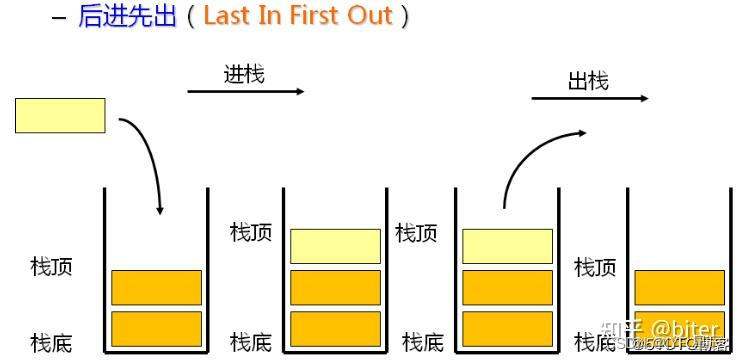【数据结构】栈【详解】
2024-01-01 17:42:32
目录
栈的定义:
栈(Stack)是只允许在一端进行插入或删除操作的线性表。
图解:

- 栈顶Top:线性表允许插入和删除的那一端。
- 栈底Bottom:固定的,不允许进行插入和删除的另一端。
- 由于只能在栈顶进行插入和删除操作,故栈的操作特性是后进先出LIFO(Last In First Out),称为后进先出的线性表。

?栈的声明与定义:
typedef int STDataType;
typedef struct Stack
{
STDataType* a;
int top;
int capacity;
}ST;?其中a是用来开辟空间的,top,capacity则分别是存储栈顶信息与栈的最大容量?
头文件的包含:?
#include<stdio.h>
#include<stdlib.h>
#include<assert.h>
#include<stdbool.h>对栈的基本操作:?
//栈的初始化
void StackInit(ST* ps);
//栈的摧毁
void StackDestory(ST* ps);
//入栈
void StackPush(ST* ps, STDataType x);
//出栈
void StackPop(ST* ps);
//输出栈顶的当前位置
STDataType StackTop(ST* ps);
//输出栈的容量大小
int StackSize(ST* ps);
//栈的判空
bool StackEmpty(ST* ps);?栈的初始化:
//栈的初始化
void StackInit(ST* ps)
{
assert(ps);//判空操作
ps->a = (STDataType*)malloc(sizeof(STDataType) * 4);//为栈开创大小为四个STDataType的空间
if (ps->a == NULL)
{
printf("malloc fail\n");//如果开创失败就非正常退出程序
exit(-1);
}
ps->capacity = 4;//否则栈的最大容量为当前开创的空间大小
ps->top = 0;//栈顶从头开始
}摧毁栈:
//摧毁栈
void StackDestory(ST* ps)
{
assert(ps);//判空操作
free(ps->a);
ps->a = NULL;//释放ps->a中的内存并使其指向空,防止内存泄漏
ps->top = ps->capacity = 0;//同时容量置空,栈置零
}入栈:??
代码解释:?
//入栈
void StackPush(ST* ps, STDataType x)
{
assert(ps);
//满了就增容
if (ps->a == ps->capacity)
{//用tmp暂时存储当前开创的内存
STDataType* tmp = (STDataType*)realloc(ps->a, ps->capacity * 2 * sizeof(STDataType));
if (tmp == NULL)
{
printf("realloc fail\n");
exit(-1);
}
else
{
ps->a = tmp;//将内存赋予栈
ps->capacity *= 2;//同时容量扩大两倍
}
}
ps->a[ps->top] = x;//入栈
ps->top++;
}
出栈:??
?代码解释:
//出栈
void StackPop(ST* ps)
{
assert(ps);
assert(ps->top > 0);
//ps->a[ps->top--]=0;
ps->top--;
}输出栈顶位置:
//输出栈顶位置
STDataType StackTop(ST* ps)
{
assert(ps);
assert(ps->top > 0);
return ps->a[ps->top - 1];
}输出栈的当前大小:?
//输出栈的当前大小
int StackSize(ST* ps)
{
assert(ps);
return ps->top;
}判空操作:?
//判空操作
bool StackEmpty(ST* ps)
{
assert(ps);
return ps->top == 0;
}
?测试结果:
?

?最后,完整代码:
#include<stdio.h>
#include<stdlib.h>
#include<assert.h>
#include<stdbool.h>
typedef int STDataType;
typedef struct Stack
{
STDataType* a;
int top;
int capacity;
}ST;
//栈的初始化
void StackInit(ST* ps)
{
assert(ps);//判空操作
ps->a = (STDataType*)malloc(sizeof(STDataType) * 4);//为栈开创大小为四个STDataType的空间
if (ps->a == NULL)
{
printf("malloc fail\n");//如果开创失败就非正常退出程序
exit(-1);
}
ps->capacity = 4;//否则栈的最大容量为当前开创的空间大小
ps->top = 0;//栈顶从头开始
}
//摧毁栈
void StackDestory(ST* ps)
{
assert(ps);//判空操作
free(ps->a);
ps->a = NULL;//释放ps->a中的内存并使其指向空,防止内存泄漏
ps->top = ps->capacity = 0;//同时容量置空,栈置零
}
//入栈
void StackPush(ST* ps, STDataType x)
{
assert(ps);
//满了就增容
if (ps->a == ps->capacity)
{//用tmp暂时存储当前开创的内存
STDataType* tmp = (STDataType*)realloc(ps->a, ps->capacity * 2 * sizeof(STDataType));
if (tmp == NULL)
{
printf("realloc fail\n");
exit(-1);
}
else
{
ps->a = tmp;//将内存赋予栈
ps->capacity *= 2;//同时容量扩大两倍
}
}
ps->a[ps->top] = x;//入栈
ps->top++;
}
//出栈
void StackPop(ST* ps)
{
assert(ps);
assert(ps->top > 0);
//ps->a[ps->top--]=0;
ps->top--;
}
//输出栈顶位置
STDataType StackTop(ST* ps)
{
assert(ps);
assert(ps->top > 0);
return ps->a[ps->top - 1];
}
//输出栈的当前大小
int StackSize(ST* ps)
{
assert(ps);
return ps->top;
}
//判空操作
bool StackEmpty(ST* ps)
{
assert(ps);
return ps->top == 0;
}
void TestStack()
{
ST st;
StackInit(&st);
StackPush(&st, 1);
StackPush(&st, 2);
StackPush(&st, 3);
StackPush(&st, 4);
StackPush(&st, 5);
while (!StackEmpty(&st))
{
printf("%d ", StackTop(&st));
StackPop(&st);
}
printf("\n");
}
int main()
{
TestStack();
return 0;
}博客到这里也是结束了,喜欢的小伙伴可以点赞加关注支持下博主,这对我真的很重要~~
?
文章来源:https://blog.csdn.net/2302_79862386/article/details/135325928
本文来自互联网用户投稿,该文观点仅代表作者本人,不代表本站立场。本站仅提供信息存储空间服务,不拥有所有权,不承担相关法律责任。 如若内容造成侵权/违法违规/事实不符,请联系我的编程经验分享网邮箱:veading@qq.com进行投诉反馈,一经查实,立即删除!
本文来自互联网用户投稿,该文观点仅代表作者本人,不代表本站立场。本站仅提供信息存储空间服务,不拥有所有权,不承担相关法律责任。 如若内容造成侵权/违法违规/事实不符,请联系我的编程经验分享网邮箱:veading@qq.com进行投诉反馈,一经查实,立即删除!